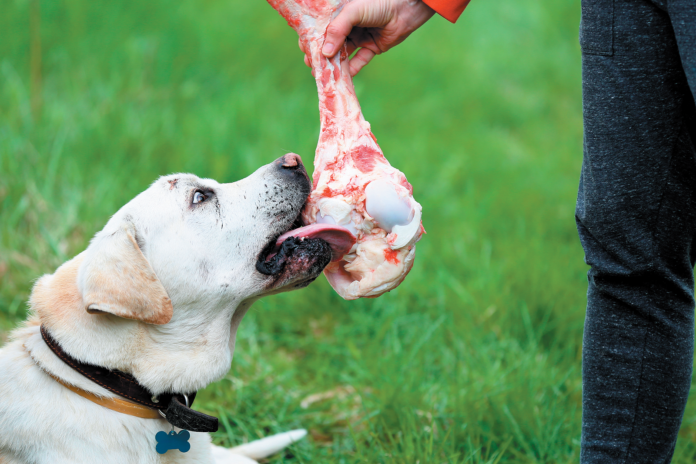If scientific study showed that raw food diets are better for dogs than cooked food and also that they are safe to feed for both pets and people who come into contact with them, we would actively recommend them. Our aim is to keep dogs — and their human families — as healthy as possible and also to make improvements in dogs’ health whenever research shows us how. We have nothing to gain, financially or otherwise, by keeping the truth from people who love their pets.
The problem is that while more people are switching to raw food diets for their dogs, the scientific evidence for their benefit remains nil. Yes, anecdotally, consumers and manufacturers of raw food regimens tout their benefits. But if you go to the website for the National Library of Medicine and put “raw diets for dogs” or “benefits of raw diets for dogs” in the search bar, not a single research article comes up that arrives at a positive conclusion. There are no studies in reputable journals that have been reviewed at arm’s length by investigators in the field proving any benefit of raw food over cooked for our canine companions. The only thing that does come up is a single survey of dog and cat owners — a multi-person testimonial rather than an actual feeding study that looked at the health of dogs fed raw versus cooked food.
On the other hand, many studies and governmental reports make clear that raw diets present all kinds of risks for dogs as well as their human families, particularly when it comes to bacterial contamination. In fact, the first study listed when you search for the benefits of raw diets is called “Raw diets for dogs and cats: a review, with particular reference to microbiological hazards.” It’s not surprising since raw meat is well known to harbor harmful bacteria. (Proper cooking kills these bacteria.) Uncooked meat allows these microbes to make their way into a dog’s gastrointestinal tract and cause serious illness.
At least as bad, handling the pet or the food can also make people sick. And studies have definitively shown different raw diets laced with bacteria. A fairly recent one out of Switzerland detected significant amounts of bacteria in raw meat dog diets that are resistant to the effects of antibiotics and therefore would make it harder to treat someone who became sick from the pathogens.
Why the erroneous belief about raw food’s benefits?
It’s understandable that people would assume raw meat is good for dogs. Oftentimes switching from canned or dry pet food to raw improves the look of a dog’s coat, making it shinier and more lustrous. But that’s just because raw meat diets often have a high fat content. Cooked foods with a similarly high fat content will also make dogs’ coats look great. (Not all dogs should be on a particularly high-fat diet, including those who are obese and those prone to pancreatitis, a dangerous and sometimes deadly inflammatory disease of the pancreas.)
Some people get taken in by the idea that raw meat is “natural.” Wolves don’t cook their food, after all. But dogs are not domesticated wolves — carnivores who best subsist on a diet of meat. While wolves are carnivores (who do also eat some plant foods), dogs are omnivores, thriving on a mixed diet of both flesh foods and plant foods. In fact, that’s one of the big differences between the two species – dogs are genetically differentiated from wolves in part because of their increased ability to produce the enzymes needed to digest carbohydrates. Dogs can digest the carbohydrates in vegetables, grains, and other plant matter much, much better than wolves can.
We shouldn’t be taking our cues from wolves living in the wild, anyway. That’s like saying we should live exactly like our prehistoric ancestors, ignoring science that has dramatically increased our lifespans.
Here are some other myths perpetuating the idea that raw food is the way to go — and the truths that should dispel them once and for all.
Raw Food Myths
Myth: Freezing or freeze-drying raw foods kills harmful bacteria.
Fact: Most of the bacteria in raw diets can survive freezing just fine. If they couldn’t, it would be safe for you to remove a frozen hamburger patty from the freezer and eat it after letting it thaw. (It’s not.)
Myth: Cooking destroys enzymes in food that are needed for digestion.
Fact: The enzymes needed for digestion are not in food. They’re in the dog’s digestive tract, secreted by the pancreas as meals make their way from the stomach to the small intestine.
Myth: Cooking destroys essential nutrients in food.
Fact: Heat does degrade certain nutrients, such as the B vitamin thiamin. But reputable pet food companies make sure that their dog foods contain the right amounts and proportions of all vitamins and minerals by taking into account losses from processing or storage. If cooking made diets irredeemably nutrient-deficient, we’d all be walking around weak and sick with serious deficiencies.
Just as dogs are at risk for vomiting, diarrhea, and worse ills from consuming bacteria that may be lurking in raw food, so are people. In fact, people may be at even more risk. Harmful bacteria like Salmonella and E. Coli may not be cleaned thoroughly enough off utensils, dishes, counters, and hands that are used to feed a dog. Even being licked by a dog who has ingested those and other types of bacteria can potentially end up making someone sick. This is especially true for people who are very young, old, or at risk because they have compromised immune systems resulting from an illness.
Ironically, a recent study indicated that many people who feed their dogs raw food diets do not implement appropriate food safety measures in the kitchen for keeping the bacteria from spreading beyond the food itself.
There is enough risk involved that both the Centers for Disease Control and the Food and Drug Administration advise against feeding raw meat diets to pets.






Most of the “evidence” I can find in support of raw diets leads back to known purveyors of disinformation. Granted, I’m a layperson, but that’s concerning.
Yes, I fell for it. Once. It nearly killed one of my pups. Never again.
10 year old black Lab- fed The Farmers Dog raw for 3 years. Yes her coat is shiny, her weight is perfect(56 1/2lbs) her teeth are still white, and I have a very minimun of poop to pick up and yes it is expensive.
It isn’t totally raw and it has been gently cooked but the idea of kibble in my mind loses some nutrients. As long as I feel I can afford it I will continue. And for the record I am fully aware of possible bacteria.
My thoughts exactly.